Which heating radiators for an apartment are better: cast
During the overhaul of the apartment, especially in the houses of the old housing stock, it makes sense to completely replace the heating system, since the old pipes and household heating devices over the long years of their service are covered from the inside with a thick layer of lime and fatty deposits, scale and rust.
Over time, such deposits significantly narrow the cross-section of the inner lumen of the pipe, which in turn impairs its throughput, as well as reduces the thermal conductivity of the material from which the battery is made, and reduces its heat transfer, which together leads to a significant reduction in the efficiency of the heating system.
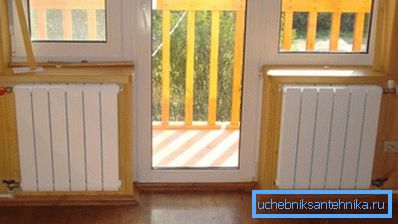
Brief comparative characteristics of different types of radiators
Taking into account the wide range of products offered in modern construction stores, many residents are interested in the question: which heating radiators should be installed in the apartment, since not only the overall efficiency of the heating system, but also the size of annual heating costs and above all , own safety of apartment residents.
In order to substantively study this issue, in this article the reader will be offered a review instruction, which presents the comparative characteristics of the most common types of radiators used in modern heating systems of residential houses and apartments.

Cast iron cast iron radiators
The most common for most city dwellers are massive cast-iron batteries made of gray cast iron, which for many years have been at the top of the rating of heating radiators for an apartment or a private residential building connected to a centralized heating system.
Among the tenants of modern homes, they are not very popular, because they were replaced by more advanced heating appliances.
At the same time, answering the question, which cast-iron radiators for apartment heating is best installed in houses with centralized heating, it is necessary to note their positive and negative sides compared with other similar devices.
- Gray cast iron is characterized by high heat transfer coefficient and resists corrosion well., Therefore, such devices have good energy efficiency, are not demanding on the qualitative composition of the coolant and can work for a long time in continuous operation mode;
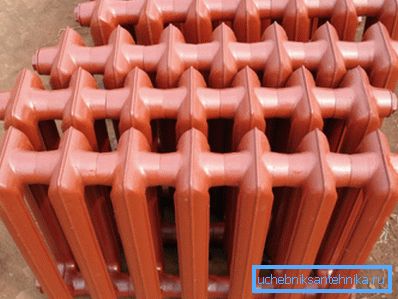
- Vertical flow channels with a large cross-sectional area have low flow resistance, thanks to which they provide high throughput and free circulation of the coolant even in the presence of traces of corrosion and salt deposits;
- Due to the large thickness of the cast-iron walls, high mechanical strength is ensured., allowing such batteries to withstand high temperatures and significant pressure drops that can be caused by hydraulic or steam shocks during peak loads or routine tests of centralized heat networks;
- The large specific weight of cast iron is compensated by its high heat capacity., thanks to which such heating devices accumulate and retain heat for a long time, gradually giving it to the room as it cools.
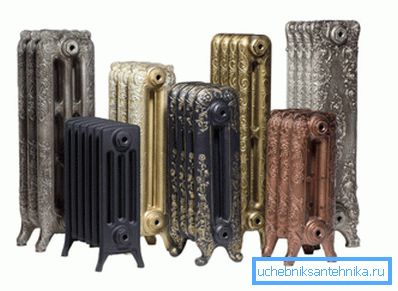
Note! The main drawbacks of standard cast iron batteries are considered to be their uniform design and cumbersome unattractive appearance, but they are easy to hide from prying eyes by installing a protective decorative screen made in the general style of the apartment interior design.
Aluminum Alloy Radiators
Relatively recently, sectional radiators made of aluminum or its alloys appeared on the building materials market, with the result that many buyers have a reasonable question: which aluminum radiators for an apartment are best used in electric or gas autonomous heating systems of their homes.
In order to understand how effective their use is, first of all, one should also consider their main advantages and disadvantages in relation to other heating appliances.
- Aluminum and its alloys resist corrosion when interacting with clean water, but quickly corrode under acidic or alkaline conditions, therefore, they should be used only in closed systems of autonomous heating;

- A positive feature of these materials is a high heat transfer coefficient and a very low inertia. (rapid heating and rapid heat transfer), which allows minimizing the volume of coolant, as well as using them in systems with automatic temperature control in the room;
- The modular design allows you to manually dial the required number of radiators in one section, selecting, thus, the optimum thermal capacity of the battery for each specific room;
- Small weight, compact overall dimensions and original design with a wide range of various colors allows these devices to remain unobtrusive, non-accented attention, interior detail.
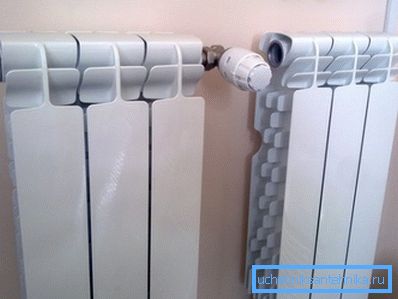
Note! The main disadvantage of aluminum radiators is low mechanical strength and a small maximum working pressure, therefore they are prohibited from using in centralized heating systems in which hydrodynamic shocks and short-term pressure increase are possible.
Steel water convectors
Considering the question of which steel heating radiators for an apartment are better suited than others as a heat exchanger in residential areas, first of all, they should be briefly examined.
In most cases, they are made in the form of a thin-walled steel pipe, to which vertical side fins and a metal shield are welded.
Thanks to this design, their principle of operation is slightly different from the work of ordinary water batteries.
- In addition to infrared thermal radiation, which underlies the operation of most household heating devices, the convection principle is also used in such devices.;
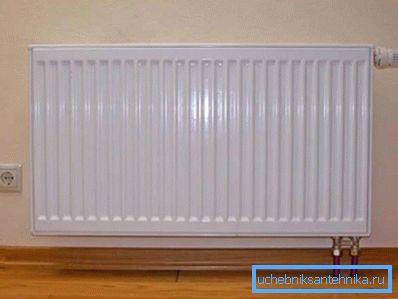
- In this case, the cold air from the floor, coming from below, passing between the fins of the convector, heats up and rushes up., leaving through the upper grille, and in its place comes a fresh batch of cold air, ensuring the constant circulation of the heated air masses in the room;
- Answering the question which radiators are better in an apartment, cast iron batteries or metal convectors, it should be noted that the latter are characterized by high heat dissipation, low inertia and higher aesthetic qualities, while they are much cheaper than radiators made of aluminum alloys.

Note! The use of a thin-walled steel pipe significantly reduces their strength and corrosion resistance, and also reduces the resistance to the effects of water hammer, so it is recommended to install steel convectors in closed autonomous heating systems.
Bimetallic radiators
The most optimal technical solution is considered to be modern bimetallic batteries, so if we consider the question: which heating radiators are better for an apartment with a centralized steam or water heating system, it is recommended that most residents use this option.
The bimetallic battery is an internal frame of steel flow tubes encased in an aluminum radiator and has the following technical features:
- The inner surface of the steel pipe has low hydraulic resistance and has sufficient corrosion resistance in aggressive environments., therefore provides free circulation of the coolant for a long time;
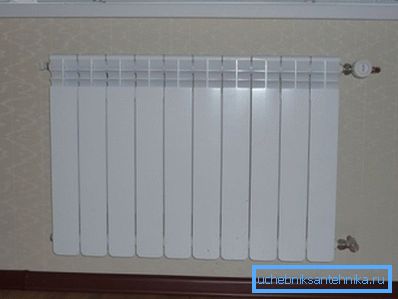
- The combination of steel pipe with aluminum shell provides high mechanical strength, therefore, such batteries can withstand high temperatures and significant hydrodynamic loads, due to which they can be installed in virtually any heating system;
- The outer aluminum shirt with heat dissipating fins has all the positive qualities of aluminum radiators., which are listed in the corresponding section of this article.
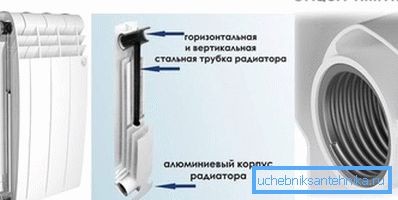
Note! In some models of bimetallic radiators lateral fins are made according to convection type, therefore such devices contribute to a more uniform distribution of heated air in the room.
Copper finned radiators
If it is subjective to talk about which radiators are better to put in an apartment, of course, the leading position is occupied by batteries made of copper, which are one or two circuits of copper pipes with copper side fins, placed in a grate decorative protective housing.
- The thermal conductivity of copper is more than two times higher than that of aluminum, and almost six times higher than that of steel or cast iron., therefore, any radiators made from this material are most effective;
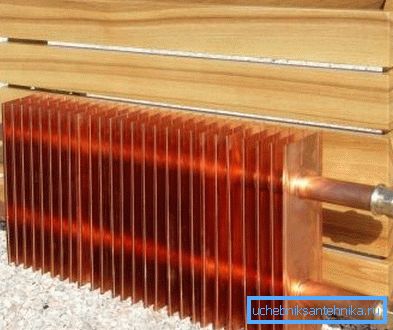
- Due to the very low inertia, copper batteries can be considered as the best heating radiators for an apartment., because they allow you to automatically maintain the desired air temperature in a heated room with great accuracy, and for their work using the minimum amount of coolant;
- Copper and its alloys after some time become covered with an oxide film, which does not collapse from high temperature and well protects the metal from corrosion under the influence of water or any other aggressive substances., therefore, such systems are highly reliable and durable.
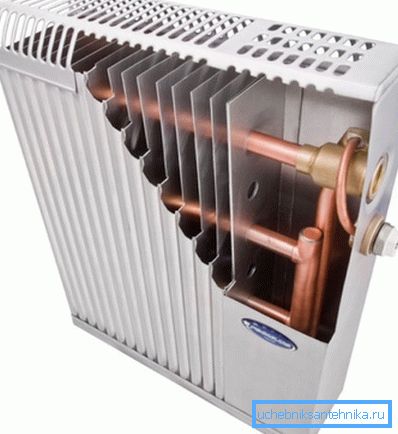
Note! The most significant drawback of copper radiators is the relatively high price of materials, as well as the need to use special tools and equipment necessary for hermetic soldering of pipelines.
Conclusion
From all that has been written, the following conclusion can be made: for installation in apartments with central water heating it is best to use bimetallic radiators, or alternatively, conventional cast iron batteries, and for systems of independent water heating with electric or gas boilers any of the presented radiators will work.
If you carefully review the attached video in this article, you can get a more complete picture of modern household heating appliances.